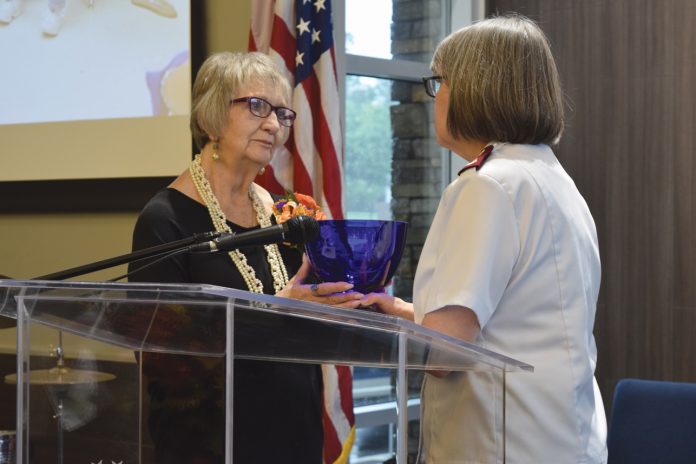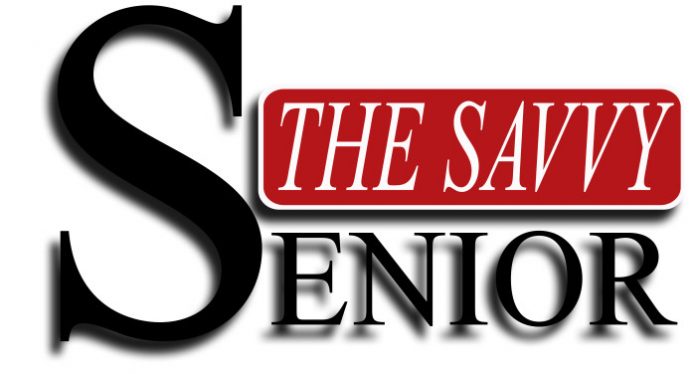The Oklahoma State Department of Health (OSDH) will offer flu vaccine statewide beginning Monday, Oct. 1 at all county health department locations. Flu shots will be provided at no out-of-pocket cost to recipients. Those with insurance are asked to provide their card showing coverage.
Flu vaccination is recommended each year for everyone 6 months of age and older. When more people are vaccinated against the flu, there is less opportunity for flu to spread in families, schools and communities. The flu vaccine is formulated each year to keep up with flu viruses as they change. Also a yearly flu shot is needed because a person’s immune protection from being vaccinated decreases after a year, and yearly vaccination provides the best protection against the flu through the entire flu season.
OSDH Interim Commissioner Tom Bates will help kickoff the effort by getting his immunization at the Rogers County Health Department in Claremore next Wednesday morning, October 3.
“We are encouraging everyone to get their flu vaccination and we hope this effort to provide the shots at no out-of-pocket cost to recipients will make it more accessible,” said Bates. “The last season was especially devastating and we want to ensure that as many people as possible can receive the added protection that the flu vaccine provides.”
Last flu season there were 291 deaths and 4,819 hospitalizations between September 2017 and May 2018.
OSDH Clinics Offering Flu Vaccine Beginning October 1 with No Out-of-Pocket Cost
Third time’s a charm

by Bobby Anderson, Staff Writer
Lisa Sydnor’s family has a pool going.
As her third retirement begins this month, many of her family members are betting this one will last about as long as the others have.
“I think I was not meant to ever stop … I can’t do nothing,” Sydnor laughed. “I don’t do that well. I’m not a big TV person and I definitely don’t do daytime soaps and game shows. I like to read and I like movies but that gets boring. You can only rearrange your drawers and closets so many times.”
For the past 50 years Sydnor, most recently the senior programs manager for the Salvation Army Central Oklahoma Area command, has been helping people put their lives together.
Whether it’s raising funds or raising families up when they have no place to go, Sydnor has devoted her life to helping others.
“It’s really not about me but about God providing the opportunity to be the conduit,” Sydnor said in her final week. “It hurts my heart and I’m going to miss it terribly but I am tired and it takes lots of energy to do that job. I just don’t have it every day.”
“I’m looking for great things to happen … and I know they’ll take great care of our seniors.”
More than 50 years of Sydnor’s life have been spent in the non-profit world.
She started with the Oklahoma Museums Association in the mid 1970s doing a little bit of everything.
“I was the secretary/bookkeeper/go-to-gal,” Sydnor said.
Her boss gave her the ideas and she was expected to run with them. It was rewarding and Sydnor embraced her autonomy and her mistakes.
“I learned a lot about what not to do and how to do it better,” she said. “I had a really great experience so I thought I was going to stick with this and see where it goes.”
Fortune smiled on her and she began 10 years with the YMCA in fundraising. From there, Oklahoma City University was her new home under Dr. Jerald C. Walker.
“He was convinced we could raise money for anything and because he was convinced that we could we did,” said Sydnor, who managed the many of the university campaigns.
From there the American Red Cross came calling. She was there nearly another decade.
She started out as a chapter solutions manager. It was a title she wasn’t quite sure of.
“My boss said it was a brand new position and this is what we want the end result to be but we don’t quite know how to get there,” she said.
There were another 25 employees just like her across the country in the late 1990s.
Helping mom and pop Red Cross Chapters consolidate and work together was part of her job. She met resistance but still had fun.
She took her skills to Montana and Wyoming and worked her magic again, helping the Red Cross become efficient.
“That was an amazing five years,” Sydnor said. “I had some amazing experiences and we also did disaster fundraising. It was a really crazy time but we had some amazing fundraisers and we always met our goal.”
Sydnor found her herself getting all the credit for the successful fundraisers after disasters.
“It was one of those things were you picked the people and sent them to do what they did best,” she said. “That was one of the most amazing times.”
A year in Dallas and three years at another company and one month of retirement bridged her gap to Salvation Army.
“The Salvation Army has given me … the icing on the cake,” Sydnor said. “I got to help so many people and it was just blessed by God. It seemed like every time we wanted to do something we were able to do it because we got the money and we could serve people.
“I couldn’t have imagined six years ago that I would have the incredible experience I’ve had there.”
Co-workers say she’ll be missed.
“Lisa is soft spoken yet strong willed,” said Keri Griffin, Salvation Army food services manager. “She is a woman of integrity who stands firm on her word. She will confront any and every situation or hardship until the job is finished and everyone around her is satisfied.
“She will definitely be missed here at The Salvation Army but I know her job is not yet done.”
Her tireless effort will be remembered.
“My first impression of Lisa was her heart for the senior population,” said Diane Maguire, senior center coordinator for the North District. “I saw first-hand how that played out every day in her life…she loved them and everything she did was motivated by this love and care.”
New CNO Named at INTEGRIS Baptist Medical
Lewis Perkins, RN, BSN, MSN, DNP is named Chief Nursing Officer for INTEGRIS Baptist Medical Center and it’s affiliated entities.
Lewis is currently the System Vice President of Nursing at Norton Healthcare in Louisville, Kentucky where he has worked since 2011.
Lewis has an incredible career in nursing leadership with significant MAGNET experience, he serves on the APRN Practice Committee for the Kentucky Board of Nursing and brings a wealth of nursing leadership experiences and innovative ideas to the table.
Lewis will begin his duties at INTEGRIS on Oct. 1. He and his wife (also a nurse) have a son in college and a son in high school who will be re-locating to Oklahoma City at the end of the school year.
Feeling your way through the Finger Lakes of New York
Photography and Text by Terry “Travels with Terry” Zinn t4z@aol.com


A road trip guarantees a real senior travel adventure. A week’s driving through the glacier formed Finger Lakes of West Central New York State, is barely enough time to explore this sampling of Americana.
Flying in and out of Rochester gives you the opportunity to tour the Eastman House (www.eastmanhouse.org) with its photography research center, and the unique Strong National Museum of Play (www.strongmuseum.org).
On your way to your overnight in Canandaigua you’ll see the Erie Canal with a quick stop in Pittsford, and see how the canal is adapted today to leisure activities. Also on the way in Mumford is the Genesse Country Village and Museum (www.gcv.org).
And what would a road trip be without getting slightly lost, or thinking you are lost? A correctly programmed GPS system in your car will become invaluable and a real comfort while traveling the many back roads of the expansive Finger Lakes. This was my first time with a talking map, and after we came to an “understanding” the device was an asset to the road trip adventure. Continuing on you may want to drive the twisting wooded roads of Letchworth State Park, which is listed as the grand canyon of the east, and does have some surprisingly nice scenic turnouts.
Over night at the comfortable Bristol Harbor Resort in Canandaigua is highly recommended and a brief home base for touring the Canandaigua Lake area. The town itself has quaint architecture and a stop off at the finger lakes visitor bureau at 25 Gorham street, can be helpful for last minute directions and touring advice. The office encourages visitors to contact them for information on the area and what sights a first time visitor might like to see. It was invaluable to me, as I picked from their extensive catalog the areas I found interesting and they were able to offer a suggested itinerary.
Jump in your car and drove south on Rt 21 towards Naples. Let your intuition choose which of the road side offerings to sample gifts, wines and foods. There are so many it would be hard to see them all but I enjoyed the small but packed Monica’s pies (www.monicapies.com). A most original and indigenous treat are the grape pies, a sweet treat with a homemade goodness, which has won many awards.
Grapes in New York state of course are made into wines and the Imagine Moore Winery (www.imaginemoorewinery.com) has a congenial wine tasting house right next to a vineyard. I found their wine good enough to buy and take home. Other notable wineries in the neck of the Finger Lakes is Arbor Hill Grapery (www.thegrapery.com) and the Widmer Wine Cellars (www.widmerwine.com).
Being an art glass collector I was tempted to purchase at the local artist gallery, Artisan’s – Gifts from the Finger Lakes, (www.artzanns.com) with their well priced local art, including paintings, pottery and a few pieces of art glass.
Back to Canandaigu’s New York Wine and culinary Center (www.nywcc.com) where I was privileged to sit in on an evening Wine and Pasta pairing demonstration. My dinner in Tuscany exhibition with Chef Lorenzo Boni gave me a new appreciation of Barilla Pasta and their sauces. Now I relive a little bit of my Finger Lakes experience every time I go to my local supermarket.
Be sure and take time to relax by strolling Canandaigua’s lake shore drive and city pier with its historic boat houses. Also be aware that the Ontario county courthouse is where Susan B. Anthony was convicted and fined one hundred dollars for voting.
Another famous Finger Lakes town is Watkins Glenn, know for its race track, where it is possible with an appointment for you to drive your own car around the track. I chose to take a relaxing (and can be romantic) evening boat ride on Captain Bill’s Seneca lake dinner Cruise (www.senecaharborstation.com). An over night at the Watkins Glen Harbor Hotel (www.watkinsglenharborhotel.com) is a convenient and luxurious oasis with gorgeous views of lake Seneca.
Allow plenty of time if you wish to venture into the Watkins Glenn State Park, where waterfalls and nature combine. My time was brief as I was off to Hammonsport to be introduced to the Glenn Curtis’s Museum centering on aviation, motorcycles and other firsts. The firsts continue with a tour of the Pleasant Valley Wine company established in 1867. Forty-Five minute guided tours are offered to explain the complicated process of wine, sherry and champagne making in their expansive facility.
Next month Part Two of Touring the Finger Lakes of New York.
Mr. Terry Zinn – Travel Editor
Past President: International Food Wine and Travel Writers Association
http://realtraveladventures.com/author/zin
Raising a glass: 23rd Street armory new again

Bobby Anderson
Staff Writer
A piece of national history right here in Oklahoma City will soon be repurposed as the 23rd Street Armory is brought to life once again.
The home to Oklahoma’s National Guard for decades, the building will soon be revitalized by new owners COOP Ale Works.
The Oklahoma Office of Management and Enterprise Services (OMES) recently accepted the company’s proposal to acquire and redevelop the armory, which includes restoring the building and creating a unique experience.
“Oklahoma City is our home and we always wanted to return to the core of the city. In planning for a final home for the brewery, we wanted to find a place that is meaningful to our town and state, and gives us an opportunity to create an incredible experience,” said Daniel Mercer, co-founder of COOP Ale Works. “The Armory, with its unique history, structure and space, is the perfect fit and we believe it will become a venue that attracts visitors from across the state, country and world.”
Under COOP’s proposal, the 87,000-plus-square-foot building will be purchased from the state for $600,000 and returned to its former glory with updates to the interior functionality. The exterior will be maintained to honor its unique history with modern refreshes, including updated windows, while the inside will be transformed into a bustling brewery production floor, full-service restaurant, 22-room boutique hotel, multiple event spaces, offices and meeting rooms.
In total, COOP plans to dedicate $20 million to the overall project.
A 60-barrel, state-of-the-art brewhouse on the first floor will be the heart of the operation. Fermentation, conditioning, packaging and other production equipment will occupy the remainder of the 22,000-square-foot drill hall floor. More than 30,000 square feet of perimeter space surrounding the production floor will house brewery storage, offices, barrel aging, cold storage, shipping, receiving and more.
On the second floor, the east wing will become an 8,000-square-foot restaurant and taproom, with indoor and patio seating for more than 160 patrons. The full-service restaurant will serve a diverse collection of food and beverages. On the third floor of the east wing, dedicated event spaces will be available for community and private events.
Sean Mossman is the director of sales and marketing for COOP Aleworks. The need for expansion for COOP started two years ago, just two years after moving into a second venue.
“We began to start looking for places that could house a much bigger operation for us,” Mossman said. “Among the things we really wanted along with space was to create a brewery Oklahoma City could be proud of. To accomplish that we needed to move back into the urban core which is in the process of being revitalized.”
“When we saw the Armory and it became available it was a real no-brainer. It checked every box.”
COOP Ale Works is a craft brewery based in Oklahoma City, dedicated to brewing full-flavored beers. Since 2009, COOP has created a core lineup of six year-round canned beers in addition to four seasonal canned beers.
A 22-room boutique hotel will tie the experience together. Hotel rooms will occupy the second and third floors of the west wing of the building with a refined lobby located on the west side of first floor to welcome guests.
The proposal also includes five acres surrounding the armory building as well as leases for two adjacent properties. The additional properties will provide substantial parking, opportunities for retail and downtown living, and green space.
A new building would have been easier but Mossman said COOP wanted to strengthen ties in OKC.
“We focused early on for something on the Register of Historic Places or just meant something to the community through time,” Mossman said.
The 23rd Street Armory, constructed in 1938, was designed by architect and Oklahoma Army National Guard Major Bryan Nolen and was built as part of the Depression-era Works Progress Administration. At the time of its original construction, it was promoted as the only armory in Oklahoma funded entirely by state funds generated from oil wells located on the Oklahoma State Capitol grounds. The three-story building served as the state’s hub for the Oklahoma National Guard and the storied 45th Infantry Division.
“Our commitment to preserving the building is really important from our perspective as is doing honor to the 45th Infantry,” Mossman said. “We’ve gotten testimony from dozens of people who have went through that building and it means so much to them and they’re excited somebody is doing something with it that’s meaningful and it’s not being knocked down and forgotten.”
Mossman said COOP will invest $20 million into renovations with projected annual economic activity of $26 million to OKC.
What are you looking forward to this Fall?
What are you looking forward to this Fall? Integris Canadian Valley Hospital volunteers
I’m looking forward to being alive, being happy, successful and volunteering at this hospital.
Eugene Johnson
What I like about fall is football. We have five sons so we are a sports family.
Nancy McKinney
Being warm and helping people. If I’m warm I want them to be warm so I donate a lot of coats.
Zola Johnson
Not mowing my grass and it not being as hot. But I’m not looking forward to winter.
Nam Huynh
Did You See Hearing Loss Association?
by Ron Hendricks
Did you see us at the fair? Central Oklahoma Chapter Hearing Loss Association of America (COC HLAA) said, “Hello” to hundreds of Oklahomans with hearing loss during the Senior Day at the Oklahoma State Fair. We had one simple question – Do you know anyone with hearing loss? Spouses and friends pointed to each other, children pointed to parents, and parents pointed to teens. We invited everyone to get their hearing checked and join us for meetings. We also spoke to local organizations about hearing access and hearing loss presentations available through our organization. If you know anyone living with hearing loss, please invite them to join COC HLAA for a meeting. Together we are stronger!
COC HLAA offers two meetings each month for your convenience. Meetings are hearing friendly and they are captioned too so you can see what was said. Join us in the evening on the second Monday each month at 6:30PM and on the third Thursday at 1:30PM. All meetings are held at Lakeside Methodist Church, 2925 NW 66 and they are free. There is no charge to become a member of our chapter, to subscribe to our monthly newsletter, or to visit the Hearing Helpers Demonstration Room (HHR), 5100 N Brookline, suite 100. The HHR is open Monday-Friday, 10-3. For more information about Hearing Loss Association of America Central Oklahoma Chapter visit our website — OKCHearingLoss.org.
Historic Railway Posters and Paintings Exhibition Opens Oct. 5 at OU
The Fred Jones Jr. Museum of Art on the University of Oklahoma Norman campus opens its 2018 fall exhibition Ticket to Ride: Artists, Designers, and Western Railways, on Oct. 5. The exhibition features more than five dozen works by artists and commercial designers created between 1880 and the 1930s, the height of western railway travel.
A public opening reception will take place at 7 p.m. Thursday, Oct. 4, with a presentation by the exhibition curator and Adkins Associate Curator, Hadley Jerman. Following the talk, attendees will enjoy live music, food and a chance to win two free, roundtrip tickets on the Heartland Flyer.
The exhibition highlights how artists and railway companies together influenced lasting perceptions of the American West, particularly the Grand Canyon, the Pacific Coast and the Northwest. “Designers and artists sought railway patronage to achieve their own ends as much as railways courted image-makers for wanderlust-inducing imagery,” says Jerman. “This exhibition brings together, often for the first time, artists and designers who were engaged in parallel projects promoting western travel but also making use of railway patronage to promote their own careers and interests.”
Some, like celebrated American landscape painter Thomas Moran, sought an opportunity to camp and paint in dramatic western landscapes. Maynard Dixon, best known today for his easel paintings of the Southwest, produced many poster and billboard designs for multiple western railways which he exchanged for free transportation via “artist passes.” Women, including the Tacoma-based painter and activist Abby Williams Hill and St. Paul muralist Elsa Jemne, found in railway patronage an escape from turn-of-the-century social constraints. Other artists like W. Langdon Kihn and his teacher, Winold Reiss, bought into misguided period notions that Native populations were on the brink of “vanishing” as victims of modernity. In railway patronage, they found an entre into the indigenous communities they aimed to record.
The images in this exhibit, then, simultaneously reflect corporate railway concerns along with their creators’ enthusiasm for dramatic landscapes and Native communities, particularly in the American Southwest, Montana and western Canada. This exhibition features paintings, studies, posters and graphics that emerged from the parallel relationships between artists and commercial designers with rail companies in the transnational American West.
Guest speaker Cliff Bragdon, nephew of Langdon Kihn, whose portraits are featured in the exhibition, will give a presentation prior to the opening at 3 p.m. Wednesday, Oct. 3, in the Mary Eddy and Fred Jones Auditorium at the museum. Exhibition curator Hadley Jerman, author of the Ticket to Ride catalogue, which will be on sale when the exhibition opens, will give a gallery talk at 1 p.m. Tuesday, Nov. 13.
The museum also will use use the exhibition as a jumping-off point for its new holiday train event, All Aboard, from 6 to 8 p.m. Thursday, Dec. 13. Model trains resembling Route 66 will take over the entire Sandy Bell Gallery in the museum. Included in this new family holiday event will be Santa Claus pictures, banjo lessons, a cookie and hot cocoa bar and much more. This family-friendly event starts at 6 p.m. with a train-lighting ceremony beginning at 7 p.m.
More information about this exhibition and related programs is available on the
museum’s website at www.ou.edu/fjjma.
The Fred Jones Jr. Museum of Art is located in the OU Arts District on the corner of Elm Avenue and Boyd Street, at 555 Elm Ave., on the OU Norman campus. Admission to the museum is complimentary to all visitors, thanks to the generosity of the OU Office of the President and the OU Athletics Department.
The museum is closed on Mondays. Information and accommodations are available by calling (405) 325-4938 or visiting www.ou.edu/fjjma.
New Vaccine Provides Better Protection for Seniors
Dear Savvy Senior, A good friend of mine got a bad case of shingles last year and has been urging me to get vaccinated. Should I? Suspicious Susan
Dear Susan,
Yes! If you’re 50 or older, there’s a new shingles vaccine on the market that’s far superior to the older vaccine, so now is a great time to get inoculated. Here’s what you should know.
Shingles, also known as herpes zoster, is a burning, blistering, often excruciating skin rash that affects around 1 million Americans each year. The same virus that causes chickenpox causes shingles. What happens is the chickenpox virus that most people get as kids never leaves the body. It hides in the nerve cells near the spinal cord and, for some people, emerges later in the form of shingles.
In the U.S., almost one out of every three people will develop shingles during their lifetime. While anyone who’s had chickenpox can get shingles, it most commonly occurs in people over age 50, along with people who have weakened immune systems. But you can’t catch shingles from someone else.
Early signs of the disease include pain, itching or tingling before a blistering rash appears several days later, and can last up to four weeks. The rash typically occurs on one side of the body, often as a band of blisters that extends from the middle of your back around to the breastbone. It can also appear above an eye or on the side of the face or neck.
In addition to the rash, about 20 to 25 percent of those who get shingles go on to develop severe nerve pain (postherpetic neuralgia, or PHN) that can last for months or even years. And in rare cases, shingles can also cause strokes, encephalitis, spinal cord damage and vision loss.
New Shingles Vaccine
The Food and Drug Administration recently approved a new vaccine for shingles called Shingrix (see Shingrix.com), which provides much better protection than the older vaccine, Zostavax.
Manufactured by GlaxoSmithKline, Shingrix is 97 percent effective in preventing shingles in people 50 to 69 years old, and 91 percent effective in those 70 and older.
By comparison, Zostavax is 70 percent effective in your 50s; 64 percent effective in your 60s; 41 percent effective in your 70s; and 18 percent effective in your 80s.
Shingrix is also better that Zostavax in preventing nerve pain that continues after a shingles rash has cleared – about 90 percent effective versus 65 percent effective.
Because of this enhanced protection, the Center for Disease Control and Prevention recommends that everyone age 50 and older, receive the Shingrix vaccine, which is given in two doses, two to six months apart.
Even if you’ve already had shingles, you still need these vaccinations because reoccurring cases are possible. The CDC also recommends that anyone previously vaccinated with Zostavax be revaccinated with Shingrix.
You should also know that Shingrix can cause some adverse side effects for some people, including muscle pain, fatigue, headache, fever and upset stomach.
Shingrix – which costs around $280 for both doses – is (or will soon be) covered by insurance including Medicare Part D prescription drug plans, but be aware that the shingles vaccines are not always well covered. So before getting vaccinated, call your plan to find out if it’s covered, and if so, which pharmacies and doctors in your area you should use to insure the best coverage.
Or, if you don’t have health insurance or you’re experiencing medical or financial hardship, you might qualify for GlaxoSmithKline’s Patient Assistance Program, which provides free vaccinations to those who are eligible. For details, go to GSKforyou.com.
Send your senior questions to: Savvy Senior, P.O. Box 5443, Norman, OK 73070, or visit SavvySenior.org. Jim Miller is a contributor to the NBC Today show and author of “The Savvy Senior” book.
Do you know how to identify a scam? brought to you by >>> VALLIANCE BANK
Financial scams continue to target seniors due to scammers thinking that seniors have a significant amount of money just sitting in their accounts. Unfortunately, financial scams go unreported due to embarrassment and can be difficult to prosecute which leave seniors vulnerable with little time to recoup their losses.
To help prevent you from getting tricked into a scam, we have outlined below what a scammer is and what to do to avoid being scammed.
A scammer is the ultimate salesperson with a tempting offer or a skilled liar with a plausible story
* Easily pinpoints a victim’s vulnerabilities and appeals to emotions: sympathy, fear, loneliness * Quickly gains trust * Insist on secrecy * Shows no mercy, e.g., doesn’t take “no” for an answer
Know the Red Flags of a Scam
* Immediate action required * Insistence on secrecy * Money needed up front * Hard-to-track payment methods
Build Your Scam Defenses
* Do not be rushed into any financial decision * Assume that insistence on secrecy is a ploy to deceive you * Be suspicious of any situation that requires you to send money up front * Confirm all stories, offers or charities independently * Be very cautious about clicking on email links
Block Those Scammers
* Register with National Do Not Call Registry at www.donotcall.gov to limit legitimate telemarketing phone calls, making phone scams easier to detect * Register with www.DMAchoice.org to limit legitimate advertising mail, making mail scams easier to detect * Limit personal information on social media and choose the strictest privacy settings on social media accounts * Use antivirus software on your computer
What to Do If You Are Scammed
* Don’t be embarrassed or afraid * Tell someone you trust * Report the scam to your bank immediately to limit losses * Contact your local police and federal agencies, like the Federal Trade Commission
For more information, visit aba.com/Seniors









